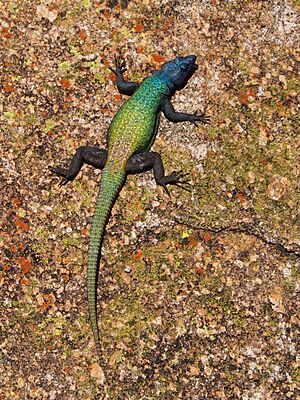Common flat lizard facts for kids
Quick facts for kids Common flat lizard |
|
|---|---|
 |
|
| Common flat lizard at Hwange National Park, Zimbabwe | |
| Conservation status | |
| Scientific classification | |
| Genus: |
Platysaurus
|
| Species: |
intermedius
|
The common flat lizard (Platysaurus intermedius) is a type of lizard that belongs to the Cordylidae family. There are nine different kinds, or subspecies, of this lizard. All of them live in southern Africa.
Contents
- What Does It Look Like?
- Where Do They Live?
- Different Kinds of Common Flat Lizards
- Wilhelm's Flat Lizard (P. i. wilhelmi)
- Rhodesian Flat Lizard (P. i. rhodesianus)
- Blackish Flat Lizard (P. i. nigrescens)
- Dark Underbelly Flat Lizard (P. i. subniger)
- Small Flat Lizard (P. i. parvus)
- Natal Flat Lizard (P. i. natalensis)
- Common Flat Lizard (P. i. intermedius)
- Unexpected Flat Lizard (P. i. inopinus)
- Nyasa Flat Lizard (P. i. nyasae)
What Does It Look Like?
Young common flat lizards and all females have black scales with white stripes on their backs. Their bellies are brown, but the edges are white. Adult males, however, have different colors depending on their subspecies.
Where Do They Live?
Common flat lizards are the most common and widespread Platysaurus lizards. They like to live under rocks that are peeling or breaking apart, like granite, sandstone, and quartzite. You can find them in moderately moist savannahs and rocky areas.
They live across a large part of southern Africa. This includes Zimbabwe, parts of Zambia, Mpumalanga, southern Malawi, eastern Botswana, Swaziland, Mozambique, and northern KwaZulu-Natal. This wide area even includes the Kalahari Desert and several big river systems.
Different Kinds of Common Flat Lizards
There are nine recognized subspecies of the common flat lizard. Each one has its own special features!
Wilhelm's Flat Lizard (P. i. wilhelmi)
Male P. i. wilhelmi lizards have green or brown backs with white spots. Their tails start red and turn yellow at the ends. Their bellies are mostly blue, but the middle part is black. You can find this subspecies in southern Mpumalanga, a province in South Africa. Scientists think this lizard might be more closely related to the Lebombo flat lizard.
Interestingly, male P. i. wilhelmi lizards tend to run shorter distances and hide from danger sooner than females.
Rhodesian Flat Lizard (P. i. rhodesianus)
The P. i. rhodesianus is one of the largest common flat lizard subspecies, growing up to 120 mm long. Males can have a blue-green or yellow-green head with three white stripes. Their back color changes depending on where they live. In most places, the front part of their back is blue-green, but in Mozambique, it's red. The lower part of their back can be green in the east or red in the west. Their tails can be greenish or yellowish.
Their necks and chests can look different too. Some have a blue throat, a black collar, and a muddy-colored chest. Others have a yellow throat, a black collar, and a green or blue chest. This subspecies lives in most of Zimbabwe, eastern Botswana, and the Limpopo area.
Blackish Flat Lizard (P. i. nigrescens)
The P. i. nigrescens is about 7.5–9 cm long. Males have a black head, chin, throat, chest, and belly. They also have yellow scales scattered on their bodies. Their tails are bright orange. You can find this subspecies near the Shoshong Hills in northeastern Botswana.
Dark Underbelly Flat Lizard (P. i. subniger)
The P. i. subniger is similar in size to the Rhodesian flat lizard. Males have a dark green back that turns brown or black towards the rear, with whitish spots. Some males from Trelawney, Zimbabwe, have uniform red backs with whitish spots. Their tails and throats are orange (though throats can also be yellow or white), while their chests and bellies are black. One female of this subspecies lived for 3.1 years in a controlled environment.
Small Flat Lizard (P. i. parvus)
The P. i. parvus is a smaller subspecies, about 65–75 mm long. Males have a dark green back in the front, which turns red-brown at the back. They can also have whitish spots. Their tails are dark orange, and their throats are pale blue. They have two black spots on either side of their neck, which is a smaller version of a collar. Their chests and bellies are blue. This subspecies lives on Blouberg mountain in Limpopo Province.
Natal Flat Lizard (P. i. natalensis)
The P. i. natalensis lives in Swaziland and KwaZulu-Natal, a province in South Africa. Its back is dark green with white spots and stripes. The tail is orange. Its throat is yellow or pale blue, with black spots and a black collar. The chest and belly have two different shades of blue.
Common Flat Lizard (P. i. intermedius)
The P. i. intermedius is 85–90 mm long and was the first subspecies to be discovered. Their heads and bodies are green or brown, with very few spots or stripes. Their tails are either red or yellow. Like many other males in this species, their throats and bellies are blue. This subspecies is found around Pietersburg and in North Province.
Unexpected Flat Lizard (P. i. inopinus)
Male P. i. inopinus lizards look and are sized similarly to P. i. parvus. The main differences are that they have white thighs with black spots and they don't have the smaller neck collar. You can find P. i. inopinus in the foothills of Blouberg in the Northern Cape of South Africa.
Nyasa Flat Lizard (P. i. nyasae)
The P. i. nyasae lives in Malawi and central Mozambique. This subspecies was discovered in 1953.


